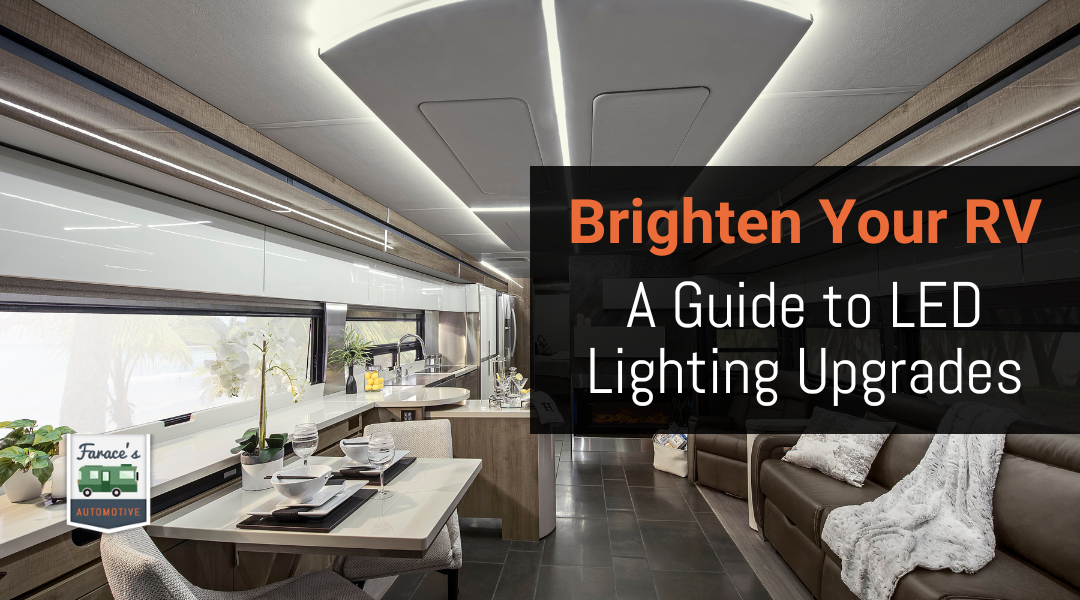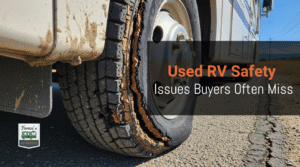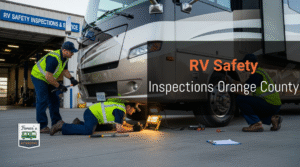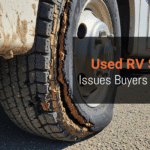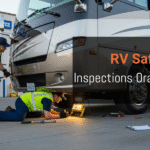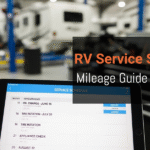Upgrading your RV lighting can greatly enhance your travel experience. If you’re looking to improve both the functionality and style of your RV’s interior, switching to LED lights is a solid option. Not only do LED lights offer better energy efficiency, but they also last longer and provide brighter illumination compared to traditional bulbs.
At Farace Automotive & RV Center in Huntington Beach, we understand the unique lighting needs of RV owners. Whether you are looking for a simple bulb replacement or a complete fixture upgrade, we have the expertise to guide you through the process. An upgrade like this can transform the atmosphere of your RV, making your adventures more enjoyable.
Discovering how to choose the right LED lights and successfully installing them can seem challenging. That’s where we come in. Our experienced team is ready to help you navigate through your options and ensure you achieve the perfect lighting setup for your travels.
Types of RV Lighting and Their Functions
Understanding the types of RV lighting is crucial for enhancing your vehicle’s usability and comfort. This section will explore both interior and exterior lighting options, highlighting their specific functions and features to consider when upgrading.
Interior Lighting – Task, Ambient, and Accent Options
Interior lighting serves multiple purposes in your RV, making it important to choose the right type for various needs.
Task lighting is designed for specific activities like reading or cooking. You can often find adjustable LED lights over your kitchen counter or reading lights above the bed.
Ambient lighting offers general illumination for larger areas. Use soft LED strips along the ceiling or under cabinets to create a warm glow.
Accent lighting adds style and highlights decorative features in your motor home. Options include LED spotlights on artwork or recessed lights to enhance architectural elements.
These lighting types let you set the mood and ensure functionality throughout your RV.
Exterior Lighting – Security, Utility, and Decorative Uses
Exterior lighting plays a vital role in safety and aesthetics while you’re parked or traveling.
Security lights can deter intruders and ensure safety around your motor home. Motion sensor lights are effective in this category.
Utility lighting helps you navigate your RV’s exterior, especially at night. Installing bright LED floodlights can illuminate your campsite or work area.
Lastly, decorative lighting can improve your RV’s curb appeal. String lights or colored LED fixtures create a welcoming atmosphere.
These options help enhance both your safety and enjoyment while parked in a spot you love.
Essential Features to Consider When Choosing RV Lights
When upgrading your RV lights, consider key features that affect performance and efficiency.
Energy efficiency is crucial, especially for off-grid living. LED lights are preferred for their low power consumption and long life, saving you energy and reducing the frequency of replacements.
Installation ease matters too. Choose lights with straightforward installation methods, whether they plug into existing fixtures or require new wiring.
Lastly, consider brightness levels. Look for adjustable brightness or dimmable options. This flexibility allows you to create the perfect ambiance for any situation.
These features significantly enhance your RV lighting experience and ensure you have the right type of light for every need.
Benefits of Upgrading to LED Lights
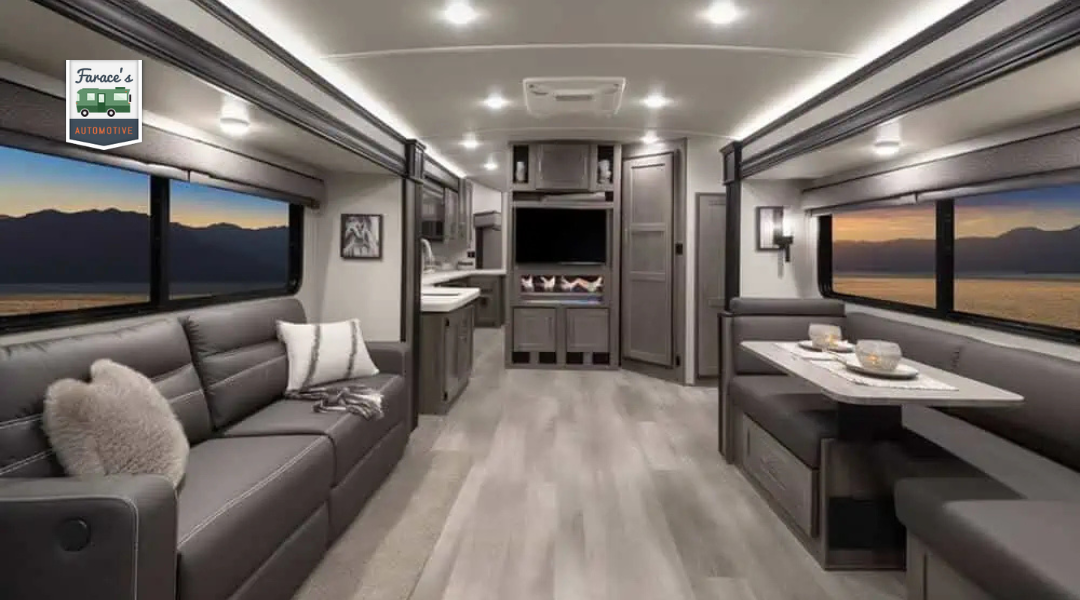
Upgrading to LED lights brings multiple advantages for your RV. You can enjoy significant energy savings, a longer bulb lifespan, customizable brightness, and less heat inside your vehicle. Each of these benefits contributes to a better camping experience.
Energy Efficiency and Lower Power Consumption
LED lights are well-known for their energy efficiency. They consume significantly less power compared to traditional bulbs. For example, an LED bulb typically uses only 10-20% of the energy of a comparable incandescent bulb.
This means you can run more lights without draining your battery as quickly. If you’re boondocking or using your RV’s battery power, this is especially important. Lower power consumption not only saves energy but also leads to cost savings on your electrical system.
Longer Lifespan Compared to Incandescent and Fluorescent Bulbs
One of the most striking benefits of LED lights is their lifespan. While incandescent bulbs often last around 1,000 hours and fluorescent bulbs about 7,000 hours, LED bulbs can last 25,000 to 50,000 hours.
This long lifespan means fewer replacements and less waste. You can spend more time enjoying your trips rather than worrying about burnt-out bulbs. Plus, fewer replacements mean lower maintenance costs, making LEDs an economical choice.
Adjustable Brightness and Color Temperature Options
LED lights offer the flexibility of adjustable brightness and color temperature. You can choose from warm white, cool white, or even colored lights to create the perfect ambiance in your RV.
Dimming capabilities also allow you to tailor the light to your needs, whether you’re reading, cooking, or enjoying a movie night. This customizability enhances your living space, making it comfortable for any activity.
Reduced Heat Emission for a More Comfortable Interior
Another important aspect of LED lighting is its reduced heat emission. Unlike incandescent bulbs, which generate a lot of heat, LED lights stay cool to the touch.
This feature helps keep your RV interior more comfortable, especially in warmer climates. It also reduces strain on your air conditioning system, helping it run more efficiently. Enjoying cooler, well-lit spaces makes for a more pleasant experience during your travels.
Choosing the Best LED Lights for Your RV
When upgrading your RV lighting, it’s essential to consider various types of LED lights and their unique features. Your choices can impact energy use, functionality, and the overall experience in your RV. Here are key points to think about when choosing the best LED lights for your vehicle.
LED Bulbs vs. LED Strip Lights – Pros and Cons
LED Bulbs
- Pros: These bulbs fit standard sockets and are easy to install. They come in various shapes and brightness levels. They provide focused light, which is great for specific areas.
- Cons: They may not cover larger areas efficiently and can be less flexible in placement.
LED Strip Lights
- Pros: LED strip lights are flexible and can be cut to fit any space. They are perfect for adding ambiance and can illuminate larger areas. This can enhance the aesthetic of your RV.
- Cons: Installation requires adhesive, and they may need additional components like connectors for longer runs.
Deciding between the two often depends on your lighting needs and desired atmosphere.
Fixed vs. Dimmable LEDs for Different Spaces
Fixed LEDs provide consistent brightness, making them suitable for areas requiring steady light, such as kitchens or workspaces. These lights offer a simple solution with straightforward installation.
Dimmable LEDs allow you to adjust the brightness. This feature is particularly useful in living areas or bedrooms, where you might want softer lighting in the evening. Dimmable options also enhance energy efficiency, as you can lower the intensity when full brightness isn’t necessary.
Think about where you need different types of light and whether you want the flexibility of dimmable options.
Smart LED Features for Remote Control and Automation
Smart LEDs come with the ability to control lights through a smartphone or smart home system. This feature allows you to turn lights on or off remotely, which can be convenient when settling into a campsite.
Many smart systems also support scheduling, enabling you to automate when lights turn on and off. Some models offer color options and adjustable brightness, giving you the ability to set the mood quickly.
Consider integrating smart features into your RV for added convenience and improved energy management.
Weatherproof and Durable LEDs for Exterior Use
When selecting LED lights for outside your RV, ensure they are weatherproof and durable. Exterior lights face various weather conditions, so they should withstand rain, snow, and UV exposure.
Look for lights rated specifically for outdoor use. Such lights often come with protective casings and weather-resistant materials. Additionally, durability is crucial for ensuring long-term performance despite the rigors of travel.
By choosing the right weatherproof LED lights, you ensure safety and reliability while enhancing the outdoor experience of your RV.
Installing LED Lights in Your RV

Upgrading to LED lights in your RV can significantly improve energy efficiency and enhance visibility. This section covers how to replace existing bulbs, install LED strip lights, consider wiring needs, and decide between DIY and professional installations.
Replacing Existing Bulbs with LED Equivalents
Start by identifying the type of bulbs currently in use. Most RVs use standard 12-volt bulbs. You’ll need to find equivalent LED bulbs that match both the size and base type. Check the wattage; LED bulbs typically require less power.
- Remove the Old Bulbs: Turn off the power to avoid accidents. Carefully twist or pull out the old bulbs from their sockets.
- Install LED Bulbs: Insert the new LED bulbs into the sockets. Ensure they fit snugly to avoid flickering.
- Test the Installation: Turn on the power to check if the new bulbs light up properly.
This simple change can lead to lower energy consumption and longer bulb life.
Installing LED Strip Lights for Interior and Exterior Enhancement
LED strip lights are a great way to add ambiance and functional lighting. They can be used inside and outside your RV for various purposes.
- Choose the Right Strips: Look for waterproof strips for exterior use. Select color options to match your preferences.
- Planning the Layout: Before installation, measure where you want to place the strips for an even glow.
- Cut and Attach: Most LED strips can be cut to size. Peel off the backing and stick them along the planned areas.
Use connectors if needed. Secure with additional adhesive or clips to ensure they stay in place. This enhances aesthetic appeal and offers practical lighting solutions.
Wiring and Power Considerations for Safe Installation
Proper wiring is vital for your safety and the performance of LED lights.
- Check Voltage Compatibility: Ensure all lights match your RV’s 12-volt system. Mismatched voltage can lead to bulb damage.
- Use Proper Wiring: If you modify any wiring, use the right gauge wire to handle the load. A thicker gauge may be needed for longer runs.
- Connectors and Fuses: Use quality connectors and ensure all connections are waterproof. Installing a fuse can help protect your RV’s electrical system.
Consider consulting the RV’s wiring diagram for guidance. Proper wiring ensures everything functions properly.
DIY vs. Professional Installation – What to Know
Deciding whether to install LED lights yourself or hire a professional can depend on your comfort level.
- DIY Benefits: Installation can be straightforward and cost-effective. You save on labor costs and can customize to your liking.
- Professional Installation: If you’re unsure about the wiring or prefer a perfect job, hiring a professional can give you peace of mind. They ensure everything meets safety standards.
Assess your skills and the complexity of the installation before making a choice. Knowing these factors helps you make the best decision for your RV upgrade.
Beyond LED – Advanced RV Lighting Upgrades
When upgrading your RV lighting, options beyond LEDs can enhance energy efficiency and overall experience. Consider solar-powered systems for sustainability, smart controls for convenience, customizable RGB lighting for style, and improved outdoor lighting solutions for safety.
Solar-Powered Lighting for Off-Grid and Sustainable Travel
Solar-powered lights are an excellent choice for off-grid travel. These lights harness energy from the sun, allowing you to illuminate your RV without relying on your batteries or campground power. You can find solar lights specifically designed for RV use, making installation easy.
Look for solar floodlights or path lights that can charge during the day and then light up at night. Many models are equipped with sensors that turn them on automatically as it gets dark. This feature can ensure your RV is always well-lit without any extra effort.
Motion-Sensor and Smart-Controlled Lighting Systems
Motion-sensor lighting adds a layer of convenience and security. These lights turn on automatically when you approach, saving energy and allowing you to navigate without fumbling for switches. You can install motion sensors in various areas, such as entryways, closets, and outdoor spaces.
Additionally, smart-controlled systems let you manage your lighting via smartphone apps or voice commands. This technology can further enhance your experience by allowing you to set timers and adjust brightness levels remotely. These systems are particularly useful for creating ambiance when socializing or relaxing outdoors.
RGB and Customizable Lighting for a Unique Look
RGB lighting offers limitless possibilities for styling your RV’s interior. These lights can change colors and create dynamic effects, allowing you to customize your space to match your mood or theme. You can install LED strips under cabinets, around furniture, or in other creative ways.
Many RGB systems can be controlled through apps, letting you program different colors or sequences. This feature not only enhances aesthetics but also provides practical options like adding task lighting in various colors. Use the customizable lighting to create an inviting atmosphere for gathering or calming spaces for rest.
Upgrading Outdoor and Security Lighting for Safety and Visibility
Outdoor lighting is crucial for both safety and visibility while parked at campgrounds or in remote areas. Consider installing bright LED floodlights or spotlights to illuminate your RV’s perimeter. This can deter unwanted visitors and help you see your surroundings clearly at night.
In addition to floodlights, install motion-activated lights around your RV entry points. This setup ensures that any movement triggers the light, adding an extra layer of security. You can also use pathway lights to create a safe route to navigate in the dark. Make sure these upgrades complement your RV’s design while serving practical needs.
Maintenance and Troubleshooting RV Lighting
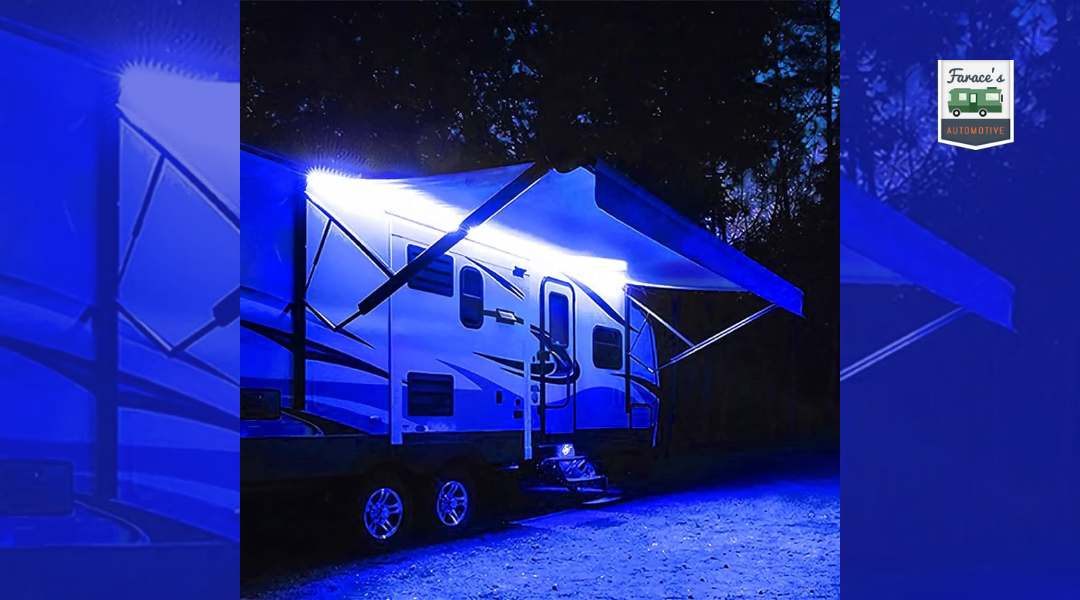
Proper maintenance and quick troubleshooting are essential for keeping your RV lighting functional and safe. This section covers common issues, tips to extend the lifespan of your lights, and how to check electrical connections to prevent failures.
Common Issues and How to Fix Them
One typical issue with RV lighting is bulb burnout. LED bulbs generally last longer than traditional bulbs, but they can still fail. If a light doesn’t turn on, start by checking the bulb.
- Replacing Bulbs: Unscrew the old bulb and replace it with a new one. Ensure it’s securely connected.
- Flickering Lights: Flickering may indicate a loose connection. Gently tap the fixture; if it flickers more, tighten or replace the connections.
Another common problem is a blown fuse. If multiple lights go out, check the fuse box and replace blown fuses as needed.
Extending the Lifespan of Your RV Lights
To maximize your RV lights’ lifespan, regular maintenance is key. Here are some simple tips:
- Keep Fixtures Clean: Dust and debris can reduce brightness. Wipe fixtures with a soft, dry cloth regularly.
- Optimal Voltage: Ensure the voltage is correct for your lights. Too high can cause bulbs to burn out quickly.
- Use LED Technology: Upgrading to LED lights not only reduces energy consumption but also provides longer-lasting illumination.
Consider installing dimmer switches. They help control brightness and reduce wear on your bulbs.
Checking Electrical Connections and Preventing Failures
Checking electrical connections is vital for preventing lighting issues. Start by inspecting all wiring for cracks or breaks. Damaged wiring should be replaced immediately.
- Secure Connections: Make sure all connections are tight. Loose connections can cause lights to flicker or not work at all.
- Avoid Corrosion: Moisture can lead to corrosion. Apply a light coating of dielectric grease to connections to keep moisture out.
Regularly testing your system will help catch problems early. Use a multimeter to check voltage and ensure all lights are receiving proper power.
Conclusion
Upgrading your RV lighting can enhance your travel experience. By switching to LED lights, you gain better brightness and energy efficiency.
Benefits of LED Lights:
- Energy Savings: LED lights use less power, helping you save on energy costs.
- Longevity: They last much longer than traditional bulbs, reducing the need for frequent replacements.
To begin your upgrade, start by assessing your current lighting. Identify which areas need more light and what types of fixtures you have.
You can choose between two main upgrade methods:
- Bulb Replacement: Simply swap out old bulbs for new LED ones.
- Fixture Replacement: Replace the entire fixture with an LED model for a more modern look.
Consider consulting professionals for installation. Experts at Farace Automotive & R.V. Center can provide guidance and help with the upgrade process.
With improved lighting, your RV can feel more comfortable and welcoming during your trips. Enjoy brighter nights and a better overall atmosphere as you explore the open road.

